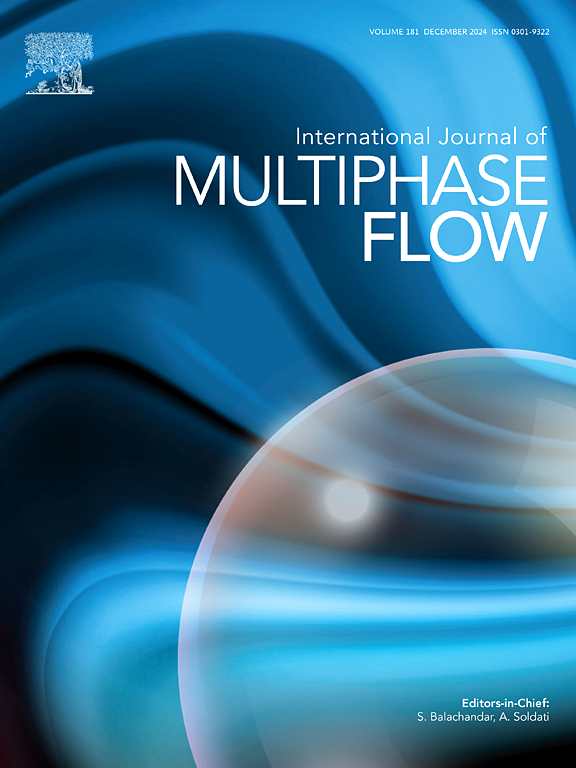内混式双流体喷嘴横流喷雾特性实验研究
IF 3.8
2区 工程技术
Q1 MECHANICS
International Journal of Multiphase Flow
Pub Date : 2025-09-20
DOI:10.1016/j.ijmultiphaseflow.2025.105461
引用次数: 0
摘要
本文研究了内混合双流体喷嘴在横流环境下的喷雾特性和液滴行为。尽管这种喷嘴在各种工业过程中具有巨大的潜力,特别是在横流条件下,但总体流动结构,特别是在下游地区,尚未得到充分的探索。通过改变气液质量流比(GLR)和横流雷诺数(Rec),利用粒子图像测速和阴影技术捕获整个流场。结果表明,GLR和Rec的变化导致了喷雾特性和液滴行为的显著差异。较高的GLR或Rec会产生更细但穿透性较差的射流核心,更薄的剪切层,更小的特征液滴直径,以及更低的峰值雷诺兹剪切应力,而在给定Rec下,较低的GLR会产生更粗的喷雾,更深的穿透,以及沿射流边界产生更强的湍流。分析了平均速度场和涡量场、Okubo-Weiss (OW)参数和Reynolds剪切应力τ,以记录双流体射流在横流中产生强剪切和涡旋运动的位置。速度场表现为射流偏转,最大穿透线与中心线之间存在高剪切带。涡度场呈现出下游减弱的相干区。OW在上层剪切层边缘突出应变主导带,近场射流边界附近τ最大。在下游轨迹位置的液滴统计数据表明,Dmax随着GLR和Rec的增加而降低,而在更远的下游观察到局部聚结驱动的再生长,液滴大小适度增加。这些结果提供了紧凑的,基于测量的流组织和液滴尺寸在测量域内的地图。本研究提供了横流中剪切和垂直结构以及液滴响应的指标,并在测量范围内报告了GLR和Rec如何影响双流体喷嘴的喷雾特性。这些发现可以为类似双流体横流系统的工况选择提供参考。本文章由计算机程序翻译,如有差异,请以英文原文为准。
Experimental investigation on the spray characteristics of an internal-mixing twin-fluid nozzle in crossflow
This study examined the spray characteristics and droplet behaviors of an internal-mixing twin-fluid nozzle operated in a crossflow environment. Although such nozzles have significant potential for various industrial processes, particularly under crossflow conditions, the overall flow structure, particularly in the downstream region, has not been fully explored. Accordingly, the gas-to-liquid mass flow ratio (GLR) and the crossflow Reynolds number (Rec) were varied, and the entire flow field was captured using particle image velocimetry and a shadowgraph technique. The results showed that changes in GLR and Rec lead to significant differences in the spray characteristics and droplet behavior. Higher GLR or Rec yields a finer but less penetrating jet core, a thinner shear layer, smaller characteristic droplet diameters, and a lower peak Reynolds shear stress, whereas a lower GLR at a given Rec produces a coarser spray, deeper penetration, and stronger turbulence generation along the jet boundary. Mean velocity and vorticity fields, the Okubo–Weiss (OW) parameter, and the Reynolds shear stress τ were analyzed to document where strong shear and vortical motions arise in a twin-fluid spray in crossflow. The velocity field shows jet deflection and a high shear band between the maximum penetration and center lines. The vorticity field exhibits coherent regions that weaken downstream. OW highlights strain-dominated bands along the upper shear layer edge, and τ is largest near the jet boundary in the near field. Droplet statistics at the downstream trajectory location indicate that Dmax decreases with increasing GLR and Rec, while farther downstream localized coalescence-driven regrowth is observed, yielding modest increases in droplet size. These results provide compact, measurement-based maps of flow organization and droplet sizes within the measured domain. This study provides indicators of shear and vortical structures and droplet response in crossflow and, within the measured range, reports how the GLR and Rec affect the spray characteristics of a twin-fluid nozzle. These findings may inform operating-condition selection for similar twin-fluid crossflow systems.
求助全文
通过发布文献求助,成功后即可免费获取论文全文。
去求助
来源期刊
CiteScore
7.30
自引率
10.50%
发文量
244
审稿时长
4 months
期刊介绍:
The International Journal of Multiphase Flow publishes analytical, numerical and experimental articles of lasting interest. The scope of the journal includes all aspects of mass, momentum and energy exchange phenomena among different phases such as occur in disperse flows, gas–liquid and liquid–liquid flows, flows in porous media, boiling, granular flows and others.
The journal publishes full papers, brief communications and conference announcements.

 求助内容:
求助内容: 应助结果提醒方式:
应助结果提醒方式:


